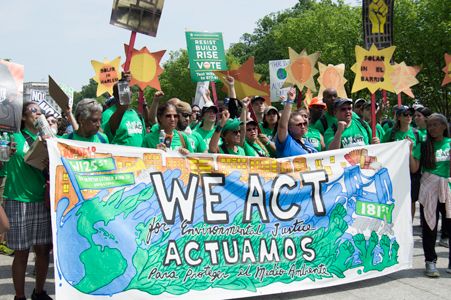The history of WE ACT for Justice goes back to 1988. Peggy Shepard was one of three neighborhood activists who recognized that West Harlem was bearing the brunt of toxic pollution.
The Environmental Justice movement was getting off the ground. Awareness was building that low-income communities and people of color were targeted for sitings by polluting industries in disproportionate numbers.
Now, the Trump administration plans to negate gains from the past eight years. Mustafa Ali, the head of the Environmental Protection Agency's Office on Environmental Justice, resigned in March.The stakeholders WE ACT represents are facing greater jeopardy.
I reached out to Shepard, to ask her what she anticipates moving ahead.
What do you expect from Trump and the EPA, and how are you preparing your community to push back?
“I anticipate a rollback of many of the regulations and policies that the Environmental Justice movement has worked on over the last twenty-five years.
We’re used to blackouts at the federal level. We lived through Bush and Reagan, and we will overcome this new hardship through commitment, hard work, and keeping our eye on the prize. Environmental Justice folks are used to being under-resourced and ignored. It has not stopped our vision and savvy at finding ways forward.
The new administration has helped motivate the grassroots and when we have regular people fired up and ready to go, good things happen.
We took four buses to the People's Climate March in D.C. last week.”

Photo: Brooke Havlik
Much of the work WE ACT did to fight air pollution was through the courts. Do you think the judicial branch of government will be successful in protecting any of the in-place legislation?
“Actually, I believe we have gained as much through the regulatory process as the courts.
We got EPA Region 2 to do air monitoring in Harlem. That data was used to promulgate the fine particulate standard.
I am not optimistic about the courts, but we will have to wait and see. Even with a win, government has to enforce and implement. If that does not happen, then the law is ineffectual. We have to monitor the laws we already have, to ensure they are enforced and complied with.”
How are you bringing awareness to health in the home, particularly with the one in four asthma rate among children in Harlem?
“We are providing leadership to a Healthy Homes coalition in New York City and support the Asthma Free Homes bill (Intro 385A), which holds landlords responsible for making repairs in a given period of time, when there is a tenant with a diagnosis of asthma.”
What is your advice to frontline communities in America on how to protect their rights over the next four years?
“Organize at the grassroots. Coordinate leadership development and issue-oriented trainings to empower, mobilize and strengthen social cohesion so regular folks understand and experience their voices being heard. We just coordinated the Environmental Justice Leadership Forum on Climate Change.
WE ACT is proud to bring an empowered, informed and mobilized constituency to the table. Once that structure is in place, a lot can be accomplished. Act locally, think globally.”
What impact will potential cuts to programs devoted to protecting children from lead paint have in New York state?
“WE ACT used to have several HUD grants over the years. We were able to run bus ads, conduct workshops around the city, and train parents how to do lead testing. We reached over 100,000 people in our last campaign. We were an active member of the NYC Coalition to End Lead Poisoning which organized to pass the most protective law in the nation, Local Law 1 of 2004. Unfortunately, we now find the city is not enforcing the law. We have to go back to court to secure the city's compliance to ensure landlords are contacting parents in their buildings who have a child under the age of 6. They must make the necessary repairs within a given period of time.
When new families and immigrants move into apartments, they do not have the information to protect their children from lead. We cannot assume that because lead poisoning incidence is down, everyone knows about this toxin. Over 80 percent of all new cases in New York City are children of color, living in the ten worst neighborhoods for housing maintenance.”
The New York City Council voted to protect low-income New Yorkers and communities of color with the Environmental Justice Study Bill (Intro 359) and The Environmental Justice Policy Bill (Intro 886A)
“We will be working on implementation in the coming months. We had this vision for years -- to get the city to focus on equity and Environmental Justice. This is a moment for us to be creative and strategic.
We need a study because government and media want documentation of what we already know to be true. As city agencies develop their plans to address identified EJ concerns, we will have some access and documentation to hold them accountable. It is easier to do that locally than federally because we have the affected residents within shouting distance of their electeds.
We must scale up our civic engagement with electoral work, holding candidates and incumbents to a higher standard, and to keep their commitments.”
This article originally appeared on the website Moms Clean Air Force
